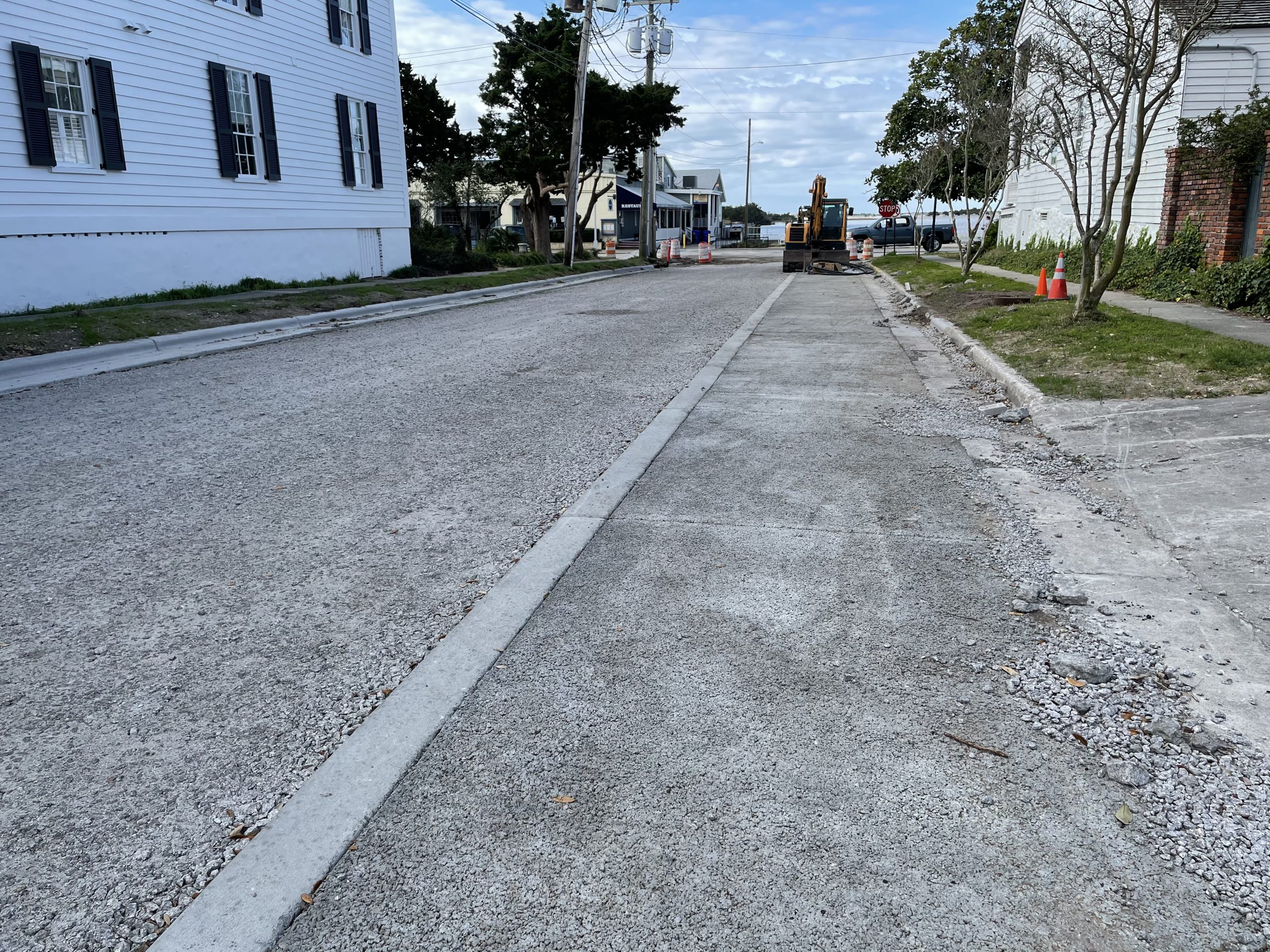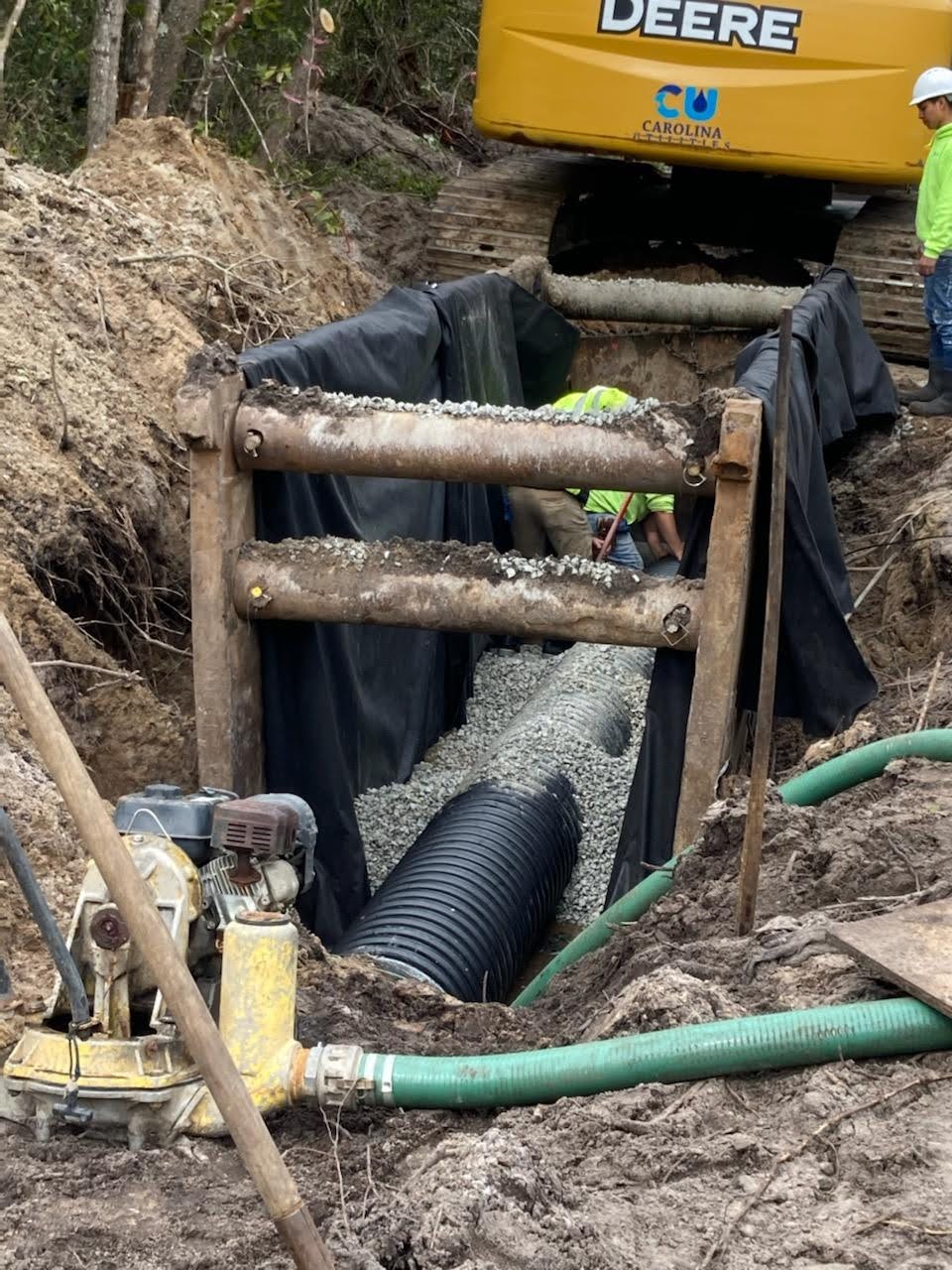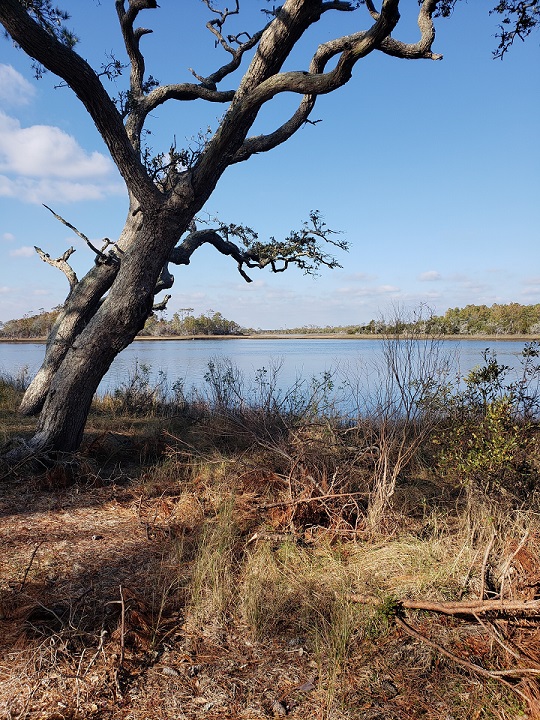
Pavement that allows water to soak through to the ground below now covers 500 feet of a street in downtown Beaufort, part of a town effort to better manage stormwater.
The town worked with the North Carolina Coastal Federation, which publishes Coastal Review, to include permeable paving as part of a capital improvement project recently completed on Orange Street to upgrade pipes and infrastructure, the federation announced Wednesday. The North Carolina Land and Water Fund provided the grant for the project.
Supporter Spotlight
Stormwater runoff from heavy rains typically flows down the hard surface of paved streets, funneling pollutants to nearby waterways. Roads typically are resurfaced with conventional paving material, but this project included permeable sections to reduce the amount of pollution from runoff.
The project is an effort under the 2017 Beaufort Watershed Restoration Plan, which provides “an overview of the past and present conditions of the Beaufort Watersheds and proposes methods and strategies intended to reduce the volume of stormwater runoff to improve water quality in the watersheds.”
The plan includes strategies to restore hydrology and reduce polluted runoff using retrofits that direct stormwater to infiltrate into the ground or collect it for later use. Officials said the retrofits are a cost-effective solution.
The goal of the plan is to “turn back the clock” on water pollution, reduce instances of flooding, align future capital improvements with stormwater retrofits, increase community awareness and position the town for future funding opportunities, according to information from Beaufort Town Planner Kate Allen.
Allen explained that some of the projects identified in the plan that have been implemented or are currently underway include recent improvements at the North Carolina Wildlife Resources Commission’s boating access area on Lennoxville Road, which reduced overall impervious surface coverage, Cedar Street improvements incorporating stormwater best-management practices and rain gardens at Tiller School.
Supporter Spotlight
“In Beaufort, we are committed to taking measures to clean up our waterways. The successful boat ramp and Orange Street pervious surface projects have been a great partnership with Coastal Federation and important parts of large-scale infrastructure improvements across our community,” said Beaufort Mayor, Rett Newton, in a news release. “By improving these systems, we are greatly reducing the amount of toxins going into our waterways as we strive to set the standard as a North Carolina Clean Water Coastal Community.”
Bree Charron, coastal specialist with the federation, is hands-on with many of these projects, including the work on Beaufort’s Orange Street.
“These projects demonstrate a balance between expense and water quality benefit. By directing impervious surface runoff to areas of permeable pavement, our partners capitalized on scheduled infrastructure repair to decrease total runoff,” said Charron in a release.
Charron told Coastal Review that the federation’s goal is to improve coastal water quality and stormwater is the No. 1 polluter of surface water in the state, so decreasing the volume of runoff that reaches coastal waters is imperative.
“While we also work on long-term goals involving state policy guidelines on stormwater, working with local municipalities offers opportunities to get more practices in the ground,” she said.
The goal of the watershed restoration plans is to decrease the volume of stormwater reaching adjacent water bodies. Reducing the volume also reduces the loading of the associated pollutants, especially bacteria. Also, addressing stormwater in the upper reaches of a watershed through nature-based design measures helps reduce downstream flooding.
Lauren Kolodij, deputy director with the federation, told Coastal Review that by developing a watershed restoration plan and implementing stormwater runoff-reduction techniques, a town can improve water quality, reduce nuisance flooding, restore natural hydrology and make waters safer for swimming and shellfishing.
By having an approved watershed restoration plan, a local government can apply for Environmental Protection Agency funding available under Section 319 of the Clean Water Act for retrofit projects and have a framework for water quality restoration funding from additional funders.
Kolodij said watershed restoration planning focuses on working together to use nature-based stormwater strategies that slow down, spread out and soak in the rain to reduce the volume of stormwater runoff.
“It sets out a community collaborative strategy for tackling local stormwater issues,” she said.
“These techniques mimic the natural hydrology of the land to infiltrate, filter, store and evaporate runoff, instead of directing stormwater to ditches, pipes and ponds that go directly to our coastal waters,” she said. “Coastal communities have been partnering with the Coastal Federation for over a decade to utilize the federation’s Watershed Restoration Planning Guidebook to develop plans.”
Atlantic Beach recently joined Beaufort, Swansboro, Pine Knoll Shores and Cedar Point in working with the federation to develop a plan to manage stormwater.
“Our partners in local government right now are fired up about water quality. And they should be, it’s what draws so many people to the coast. They are also actively looking for solutions to flooding concerns brought to them by residents. Our goal is to match flood mitigation with effective strategies that will also address water quality,” Charron told Coastal Review.
Atlantic Beach’s Recreational Water Quality Committee recommended partnering with the federation in January 2019 to create the Bogue Banks town’s watershed restoration plan, which was approved Feb. 22. The town partnered with the federation, surveying and engineering firm LDSI Inc. of Charlotte and Kinston and the New Bern-based Eastern Carolina Council of Governments to create a watershed restoration and stormwater resiliency plan, according to the town.
The plan has been sent to the NCDEQ Division of Water Resources for review and approval to ensure it meets the EPA’s nine minimum elements. Once approved, the plan makes Atlantic Beach eligible to apply for Section 319 funding to implement stormwater management strategies identified in the plan.
Michelle Shreve Eitner, director of Planning and Development for Atlantic Beach, told Coastal Review that the town is looking forward to applying for funding to implement these projects so soon after the plan was approved by Town Council.
“Sometimes plans sit on a shelf in an office, but this one is being put to use as we speak. There are several projects that not only increase water quality and reduce stormwater flooding, but also provide the opportunity for education and outreach. Low-Impact Development techniques and Stormwater Control Measures look nice on paper, but folks can be weary of implementing something they’re not familiar with. Displaying effective methods, like permeable paving or rain gardens for stormwater infiltration and retention, can help bridge that gap,” she said.
Atlantic Beach approved its plan a week before the federation unveiled a statewide nature-based stormwater strategies plan.
“This plan calls for establishing statewide effective watershed management that focuses on protecting, restoring or mimicking natural water systems to reduce flooding and improve water quality as one of four key cross-cutting recommendations,” Kolodij said.
During the press conference March 3 to introduce the statewide plan, Pine Knoll Shores Manager Brian Kramer said the town for the past four decades had been pumping polluted surface water into nearby waterways during storm events or heavy rain events.
Kramer said the town partnered with the Clean Water Trust Fund and the federation to use infiltration methods, avoid additional impervious surfaces and install swales as part of public projects to manage stormwater.
Kramer added that the town is looking at landscape designs for new construction that help with stormwater infiltration.
Charron said that in Pine Knoll Shores construction is underway on a large groundwater/stormwater management system across the east end of town, as part of a North Carolina Land and Water Fund Innovative Stormwater Project, to help address the flooding in a way that’s more water quality-friendly. There is also a project in the design phase to install a permeable “island” in the Acorn Court cul-de-sac.

In Cedar Point, work has been taking place since the mid-2000s to reduce polluted runoff into the White Oak River, which is 48 miles long and runs through Jones, Onslow and Carteret counties, said Cedar Point Town Manager David M. Rief.
He explained that the town is bounded by the river and the Atlantic Intracoastal Waterway, with major tributaries Pettiford Creek and Boathouse Creek also in the town limits.
“As such, the water quality of these bodies of water are important to the health, safety and enjoyment of our residents. It just made sense for the town to be concerned about water quality and in turn, develop a watershed restoration plan,” Rief said.
Since the plan’s development, it has been used to educate the public become more cognizant of their individual impacts to water quality and encouraging them to take a more proactive role in reducing contamination, he explained.
While a number of projects have taken place, the biggest has been the town’s purchase of a 56-acre tract fronting the White Oak River and containing 19 acres of wetlands.
“By partnering with various other entities including the N.C. Land and Water Trust, N.C. Parks and Recreation Trust Fund, the Coastal Federation, and N.C. Coastal Land Trust, we were able to acquire the property and prevent substantial development of the property, thus reducing the amount of contaminated runoff previously expected from the site,” Rief said.

Another project underway is a state Department of Transportation resiliency project to protect Cedar Point Boulevard, or N.C. 24, from hurricane erosion.
“Rather than using traditional bulkheading methods of bank stabilization, the project will use a living shoreline structure composed of oyster shells to create a naturally growing oyster reef to help slow and break up wave action in the White Oak River. Of course, the oysters will have the additional benefit of helping to clean up the water,” Reif said.
He said it’s currently difficult to quantify the impact of the improvements made so far because each year brings both more improvements and more development. Also, Cedar Point is at the confluence of the river and the Intracoastal Waterway, and what happens upstream has a huge effect on the quality of the water as it passes Cedar Point.
“Therefore, it is difficult to determine, without additional studies, what the net impact is on the water quality,” he said. And while they aren’t able to quantify the results, “we know the study prompted actions that would otherwise not have been taken, and each of those steps was in the right direction for maintaining and improving the quality of this cherished natural resource we all enjoy.”
Work is also underway in Swansboro to put in place permeable parking at Ward Shore Park, where the town installed a living shoreline last year. There is also funding to pursue retrofitting a street end outfall on Walnut Street in the coming year, Charron told Coastal Review. Both are 319 grants that the federation partnered with the town.
Charron added that sea level rise has to be considered in coastal communities. The sound and ocean are the end point of the drainage system, natural or man-made. As sea level rises, the ability to move water is hindered. Beaufort is already seeing this with some infrastructure in the downtown area. The goal would be to decrease the amount of stormwater flowing through traditional drainage pathways.
“I think the towns have sea level rise in consideration, but really preparing for the changing climatic patterns is on the forefront of these plans. While it is silly to design for a Florence-type rainfall event, it seems the ‘typical’ rainstorm is increasing in duration and intensity. Taking these heavier ‘normal’ rainfalls into account is a major focus. Being prepared for action during a Florence-type event is also on everyone’s minds,” she said.







